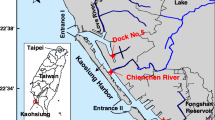Abstract
The extractability of metacinnabar and cinnabar, alone or in the presence of some sediment components, with various concentrations of HNO3 (1, 4, 6, and 14 M) was studied. Both forms of HgS (0.2–0.3 mg HgS in 10–20 mL of acid) were insoluble in all HNO3 concentrations as pure compounds. The presence of FeCl3 enhanced solubility of both cinnabar and metacinnabar, especially when concentrated HNO3 was used for the extraction. As the same effect was not obtained in the presence of FeOOH, we concluded that chloride and not Fe3+ was responsible for HgS dissolution. In fact, addition of very low chloride concentration to concentrated HNO3 provoked partial (Cl>10−4 M) or even total dissolution (Cl>10−2 M) of HgS. In dilute HNO3 (4–6 M) cinnabar was much less affected by chloride addition than metacinnabar. Extraction of HgS by concentrated HNO3 in the presence of sediment of various salinities demonstrated that the amount of dissolved HgS increased with the increase of the sediment salinity (from freshwater to estuarine and marine sediment), confirming that chloride enhances dissolution of HgS. Removal of chloride by washing the sediment with Milli-Q water significantly reduced dissolution of added HgS during extraction by concentrated HNO3. These results demonstrate that conclusions based on the extraction schemes using concentrated HNO3 as single extractant or as the first extractant in the sequential extraction procedures can be biased. A verification of artifactual oxidation of HgS, when using more concentrated HNO3 as extractant, would help to verify reliability of the applied extraction procedure.




Similar content being viewed by others
References
Stein ED, Cohen Y, Winer AM (1996) Crit Rev Environ Sci Technol 26:1–10
Davis A, Bloom NS, Que Hee SS (1997) Risk Analysis 17:557–569
Kim CS, Brown GE Jr, Rytuba JJ (2000) Sci Total Environ 261:157–168
Revis NW, Osborne TR, Holdsworth G, Hadden C (1989) Water Air Soil Pollut 45:105–112
Fabbri D, Lombardo M, Trombini C, Vassura I, Zavoli E, Horvat M (2001) RMZ – Mater Geoenviron 48:186–192
Bloom NS, Preus E, Katon JC, Hiltner M (2003) Anal Chim Acta 479:233–248
Rodriguez Martin-Doimeadios RC, Wasserman JC, Garcia Bermejo LF, Amouroux D, Berzas Nevado JJ, Donard OFX (2000) J Environ Monitor 2:360–367
Wallschlager D, Desai MVM, Spengler M, Wilken R-D (1998) J Environ Qual 27:1034–1043
Fabbri D, Gemelli S, Lagnone L, Miserocchi S, Trombini C, Vassura I (2000) Annali di Chimica 91:563–575
Simpson SL, Apte SC, Batley GE (1998) Environ Sci Technol 32:620–625
Simpson SL, Apte SC, Batley GE (2000) Environ Sci Technol 34:4533–4537
Burkstaller JE, McCarty PL (1975) Environ Sci Technol 9:676–679
Personal communication (2002) Sequential extraction data for soil sample obtained from Dr Milena Horvat
Mikac N, Foucher D, Niessen S, Ouddane B, Fischer J-C (2002) Anal Bioanal Chem 374:1028–1033
Mikac N, Niessen S, Wartel M (1999) Analusis 27:870–875
Mikac N, Niessen S, Ouddane B, Wartel M (1999) Appl Organomet Chem 3:715–725
Barnett MO, Harris LA, Turner RR, Stevenson RJ, Henson TJ, Melton RC, Hoffman DP (1997) Environ Sci Technol 31:3037–3043
Morse JW, Luther GW III (1999) Geochim Cosmochim Acta 63:3373–3378
Lamure J, Brusett H (1962) In: Pascal P (ed) Nouveau Traite de Chimie Minerale. Masson, Paris
Biester H, Gosar M, Covelli S (2000) Environ Sci Technol 34:3330–3336
Birkett JW, Norgen JMK, Lester JN (2002) Environ Pollut116:65–74
Gagnon C, Pelletier E, Mucci A (1997) Mar Chem 59:159–176
Bayens W, Meuleman C, Muhaya B, Leermarkers M (1998) Hydrobiol 366:63–79
Acknowledgements
The sample of soil (SOIL-1) was prepared in the framework of the IAEA trough the CRP entitled "Health impacts of mercury cycling in contaminated environments studies by nuclear techniques", 1999–2003. This work was supported by the Ministry of Science and Technology of the Republic of Croatia. Additional funding was from CNRS-PICS 1,250 program, CNRS-PAI Proteus, FEDER Region Nord Pas de Calais (CPER), and PNETOX program. N.M. has benefited grant from the French Government (PAST) and S.L. from CNRS.
Author information
Authors and Affiliations
Corresponding author
Rights and permissions
About this article
Cite this article
Mikac, N., Foucher, D., Niessen, S. et al. Influence of chloride and sediment matrix on the extractability of HgS (cinnabar and metacinnabar) by nitric acid. Anal Bioanal Chem 377, 1196–1201 (2003). https://doi.org/10.1007/s00216-003-2204-7
Received:
Revised:
Accepted:
Published:
Issue Date:
DOI: https://doi.org/10.1007/s00216-003-2204-7




